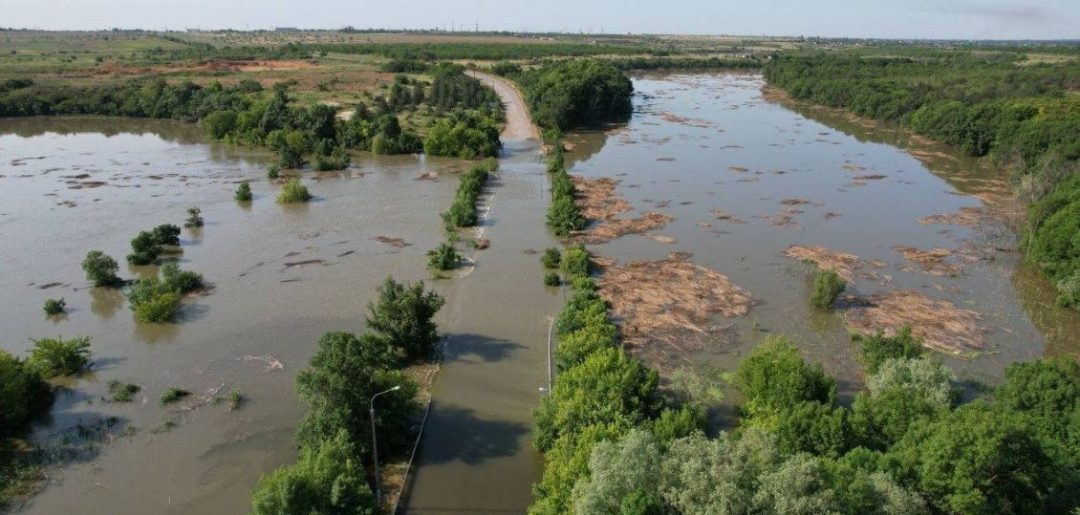An attack on a major Russian-held dam in southern Ukraine Tuesday unleashed a torrent of water that flooded a small city, two dozen villages and sparked the evacuation of 17,000 people. The flooding also heightened existing fears for the safety of the Zaporizhzhia nuclear power plant, the largest in Europe.

Moscow and Kyiv traded blame on Tuesday for ripping a gaping hole in the Kakhovka dam in what Kyiv said was an attempt by Russia to hamper Ukraine’s long-awaited offensive.
People in the city of Kherson, the largest population center nearby, headed for higher ground as water, which had been held back by the dam and a hydroelectric plant, rose in the Dnipro River.
Ukrainian authorities said 17,000 people were being evacuated and a total of 24 villages had been flooded.
The Kakhovka dam and its power plant were seized by Russia in the first hours of the war.
Ukrainian President Volodymyr Zelensky accused Russia of blowing up the dam, urging the world to “react.”
Kyiv also called for a meeting of the UN Security Council and warned of a potential “ecocide” after 150 tonnes of engine oil spilled into the river as a result of the attack.
Western powers also blamed Russia for the damage to the Kakhovka dam, with EU chief Charles Michel calling it a “war crime.”
NATO chief Jens Stoltenberg said the dam breach was “outrageous” and “puts thousands of civilians at risk and causes severe environmental damage.”
Russia, however, said the dam was partially destroyed by “multiple strikes” coming from Ukrainian forces.
Kremlin spokesman Dmitry Peskov said the destruction was the result of “deliberate sabotage by the Ukrainian side.”
The Soviet-era dam sits on the Dnipro River, which provides cooling water for the Russian-occupied Zaporizhzhia nuclear power plant.
The flooding heightened existing fears for the safety of the Zaporizhzhia plant, the largest in Europe.
The plant is some 150 kilometers (about 90 miles) away from the damaged dam.
Moscow and Kyiv offered conflicting versions on the safety of the facility.
The Russian-installed director of the plant, Yuri Chernichuk, echoed the UN agency and said that “at the moment, there is no security threat to the Zaporizhzhia nuclear power plant.”
But Ukraine, which in 1986 suffered the devastating Chernobyl nuclear disaster, sounded the alarm.
“The world once again finds itself on the brink of a nuclear disaster because the Zaporizhzhia nuclear power plant lost its source of cooling. And this danger is now growing rapidly,” Zelensky’s aide Mykhaylo Podolyak said.
The Ukrainian nuclear operator, Energoatom, said the water level of the Kakhovka reservoir was “rapidly decreasing, which is an additional threat to the temporarily occupied Zaporizhzhia nuclear power plant.”
News of the damage came after Russia claimed Ukraine had begun a long-expected counter-offensive to claw back lost territory after Moscow invaded in February, 2022.
On Tuesday, Defense Minister Sergei Shoigu announced that Moscow had halted Kyiv’s offensive but lost 71 soldiers over the past three days, an extremely rare admission of Russia’s losses.
Kyiv already accused Moscow of mining the dam as combat raged nearby in October, during the last major offensive by Ukrainian forces seeking to regain lost territory. Russia denies the claim.
Built in the 1950s, the Kakhovka dam has strategic value as it pumps water into the North Crimean Canal, which starts in southern Ukraine and crosses the entire Crimean Peninsula.
This means that any problem with the dam could cause water supply problems for Crimea, which has been under Russian control since 2014.
Roger Barake, with AFP












